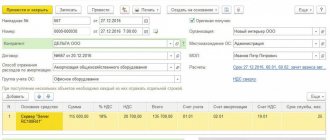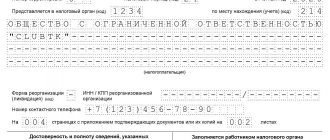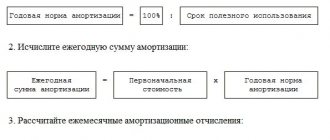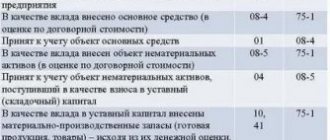Correct accounting of equipment at an enterprise is an important point for conducting business activities. First of all, the cost of equipment, or rather depreciation, affects the cost of production. In addition, incorrectly organized accounting of equipment can lead to tax penalties, since depreciation is an expense item and reduces taxable profit.
In this article, I propose to consider the stages of equipment accounting in 1C 8.3 Accounting 3.0, starting with its receipt and ending with write-off.
Receipt of equipment in 1C Accounting
To complete this operation, use the document of the same name “Receipt of Equipment”. The list of documents is located in the “Receipt of fixed assets” section (main menu “Fixed assets and intangible assets”). You can go to the list by clicking on the “Equipment Receipt” link.
In the list window, click the “Create” button. Now you can proceed to filling out the document details.
- We indicate the date and number of the primary document, the date of the document in the system. The number will be assigned automatically upon registration.
- If this information base maintains records for several organizations, select the organization. If the “Organization” field is missing in the document header, it means that records are kept for only one organization. This is a common feature for all documents.
- The selection of a counterparty can be made by TIN or by name. If it is not found in the directory, the program will offer to create it.
- If the counterparty already exists and an agreement with the “With supplier” type has been concluded with it, the agreement will be entered automatically.
Now let's move on to filling out the tabular part. On the first tab we indicate:
- Equipment that we come;
- Quantity;
- Price;
- VAT rate;
- Accounting account (usually 04/08).
Don't forget to create an invoice below.
This is what the completed document should look like:
On the “Products” tab, you can specify related products. They arrive as usual.
The “Services” tab indicates services that are not included in the cost of the equipment. For example, services related to the delivery of goods.
To reflect the services that need to be included in the cost of equipment, there is a document “Receipt of additional. expenses."
Procedure for filling out the standard form
The basis for drawing up an act of acceptance and transfer of an object for installation in the OS-15 form, as a rule, is a contract agreement.
The unified form OS-15 is filled out on both sides.
The front side contains information about the parties involved, as well as the equipment itself; the back side contains inspection data, conclusion and signatures of the parties.
Front - contains information about the name of the customer enterprise with the designation of the OKPO code, the department that accepted the equipment for subsequent installation (garage, warehouse, site).
Next, the basis for drawing up the acceptance certificate is recorded - the contract, its number and the date of signing.
After the title of the document, fill in the number of the form and the day of its preparation, on the left - the dates of delivery of the equipment for installation, under the contract and actual.
When filling out the title page of the OS-15 form, you should pay attention to the fields indicating the dates of commissioning for installation and operation:
- The day of commissioning of the assembled equipment is taken from the contract or other document - this will be the planned day.
- The actual day of transfer of working property into operation is indicated below, filled in upon acceptance of the finished object for accounting.
The place where the transfer and acceptance certificate is drawn up is indicated in full below:
- name of company;
- locality;
- Street;
- structural subdivision.
Next, the names of the enterprises of the equipment manufacturer, supplier and installation company are written down in order.
OKPO codes are indicated next to each name. Then the department that accepted the equipment for installation is registered in the OS-15 form.
All information about the set of equipment for subsequent assembly is entered into the table:
- Name of equipment;
- serial number;
- element marking;
- serial position according to the assembly diagram;
- day of arrival at the warehouse;
- number of the act of acceptance of objects, their quantity and cost (total and for an individual unit of the element).
Additional information is recorded in the last column.
On the reverse side of the acceptance certificate form, the compliance of the equipment with the presented drawings and design specialization (whether it is complete) is noted, a detailed list of all elements of the equipment is listed, indicating their quantity.
If defects are identified during the installation of equipment, a report is drawn up (form OS-16).
The final conclusion on acceptance of equipment for installation may contain the phrase “the equipment is suitable for use, no defects were identified.”
The document must contain signatures from representatives of both companies, who are responsible for maintaining the integrity of the equipment set during its assembly.
The fixed asset item is transferred to the employee responsible for ensuring the safety of the equipment.
Upon completion of installation, the equipment is accepted for accounting as a fixed asset on the basis of the drawn up act OS-1 (OS-1a).
Certification of the act of acceptance and transfer for installation with stamps is not a mandatory condition; today, legal entities have the right not to use stamped products if their need is not indicated in the local documentation of the enterprise.
The act, completed in form OS-15, is an annex to the contract for the supply of equipment, which confirms the provision of a set of objects from one company to another, their introduction or withdrawal from the production capabilities of the enterprise.
Equipment is accepted into the enterprise warehouse according to an OS-14 act, after which it is accepted and transferred for installation with the OS-15 act drawn up.
Filling out the OS-15 form is fully regulated by the legislation of the Russian Federation; its use is necessary to control the costs of various companies.
Drawing up a transfer and acceptance certificate is required for enterprises involved in the transfer of used equipment from the delivery company, as well as when purchasing a new technical object through a distribution network, an individual entrepreneur, or production with their own capabilities.
Below is a free download of the unified form and a completed example of the OS-15 form.
acceptance certificate for installation OS-15 - excel.
filling out form OS-15 - excel.
What the completed form looks like:
Compilation in free simple form
A specially designed form OS-15 contains all the necessary information about the property transferred for subsequent installation. It is not legally prohibited to develop your own form for the acceptance certificate for installation.
It should contain information:
- information about the delivery company and the recipient, if the object is new, then the delivery person is not recorded;
- the contract that serves as the basis for the purchase procedure;
- date of acceptance of equipment for registration;
- manufacturing organization, depreciation group of the object.
Sometimes a special commission is formed to carry out installation activities. One of the commission members must be a specialist from the performing company. In this case, an additional copy of the act is not required. If necessary, you can make a photocopy of the form.
When receiving equipment for storage, the authorized representative signs the document and then receives a copy of it.
In other cases, the document is drawn up at the time of transfer of equipment in 2 copies. One of them remains for the recipient, the other for the transmitting party.
It is allowed to fill out the act either by hand (only with a ballpoint pen, but not with a pencil) or using a computer.
The document is drawn up in 2 copies: one is sent to the accounting department employee, where it acts as a confirming document for the transfer of equipment from the customer to the installation organization, and also serves as the basis for registering the property as a fixed asset, the second is sent to the installation contractor.
Example
Below is a sample of how you can draw up an act of acceptance and transfer of equipment to an installation company in a free, simple form.
act in a simple form - word.
What a simple form looks like:
Receipt of additional expenses
Go to the list of additional documents. expenses can also be found in the “Receipt of fixed assets” section.
The header of the document is filled out in the same way as the receipt document.
On the “Main” tab fill in:
- Name );
- Amount and rate of VAT;
- a method for allocating costs if they relate to several items of equipment.
On the “Products” tab, respectively, equipment:
Let's go through the document and look at the postings it generated:
As you can see, the amount of additional expenses increased the cost of the machine.
Account 07 “Equipment for installation”: accounting and postings
Equipment to be used by an organization for specific purposes is divided into two categories:
- to be installed;
- not subject to installation.
The first category includes various machines and devices, pilot plants, mechanisms and electrical appliances. The main criterion for inclusion in the first category is the installation features of these objects, namely installation in walls or connection to the foundation.
The second category includes various mobile machines and devices, tools that cannot be installed by the above installation, as well as vehicles.
The first category is accounted for on account 07. For the second, accounting is carried out on account 08.
Specialized account 07 interacts with many other accounts, including:
- by debit from 08, 76, 91, etc.;
- on a loan from 15, 60, 76, 91, etc.
This account is intended for accounting of installed fixed assets by persons whose activities are related to construction and reconstruction. They take into account various machines and other objects intended for installation in newly created and converted buildings and structures.
Transfer of equipment for installation in 1C 8.3
This document also affects the final cost of the equipment and allows you to include in the price the components or equipment necessary for installation. In the header of the document we indicate the object for the construction of which the equipment is used, the cost account and the cost item.
In the tabular part the equipment is selected:
Registration of equipment transfer
When transferring equipment to the customer, which will subsequently be installed, the contractor must fill out form No. TORG-12 “Consignment note”.
The delivery note is issued at the time of shipment. On its basis, the customer will be able to capitalize the equipment received from the contractor.
Please note: since the actual transfer of equipment will be recognized as a sale, the contractor is obliged to issue an invoice to the customer within five calendar days from the date of shipment of the equipment (clause 3 of Article 168 of the Tax Code of the Russian Federation).
After completing the installation of this equipment, the contractor draws up a work completion certificate and issues an invoice to the customer for the cost of installation work.
Acceptance of equipment for registration
After registration of receipt, the equipment must be accepted for accounting.
From the same section, go to the document list form “Acceptance for accounting of fixed assets” and click the “Create” button.
Let's start filling out the document details:
- “ OS event ” – we indicate how we will accept the equipment for accounting, with commissioning or not. Affects generated wiring;
- “ MOL ” – indicates the financially responsible person to whom the equipment will be assigned;
- “ Location of OS ” is the division for which equipment records will be kept.
Let's move on to the tabular part. The first tab is “Non-current asset”. Here you need to indicate the type of operation, the method of receipt and select from the “Nomenclature” directory the equipment that was installed at the arrival:
On the “Fixed Assets” tab, select an equipment card, which must first be entered into the “Fixed Assets” directory.
This directory stores all information about fixed assets. For the most part, the equipment card is filled out automatically when you post this document. It stores information about the initial and current cost of equipment, accrued depreciation, and reference information. The data is taken from the document. When a document is changed, the data in the directory also changes.
On the “Accounting” tab, we indicate which method will be used for depreciation and the period over which the equipment should be depreciated. The depreciation account is usually 02.01. Equipment account – 01.01:
If the company pays income tax, the “Tax Accounting” tab is also filled out. As a rule, it contains the same values as in the previous tab.
Let's run the document and see what transactions it generated in 1C 8.3:
It can be seen that the equipment was registered on account 01.01.
Video on receipt and accounting of fixed assets in 1C 8.3:
Reflection of transactions in accounting
The contractor's costs for the purchase of equipment requiring installation, the cost of which is included in the estimate, are recognized as part of material costs (subclause 4, clause 1, article 254 of the Tax Code of the Russian Federation).
Note that in the contractor’s accounting, equipment purchased for the purpose of performing installation work cannot be attributed to accounts 01 “Fixed assets” and 07 “Equipment for installation,” since the contractor is not the owner of this equipment. He accounts for equipment in account 10 “Materials” (sub-account “Purchased semi-finished products and components, structures and parts”) at the actual cost, that is, at the amount of costs for its purchase without VAT. Such rules are provided for in paragraphs 2, 5, 6 of PBU 5/01, approved by order of the Ministry of Finance of Russia dated June 9, 2001 No. 44n.
DEBIT 20 CREDIT 10 – the cost of installed equipment is written off.
These expenses are written off to the debit of account 90 “Sales” (sub-account “Cost of sales”) on the date of recognition of revenue from the work. This follows from paragraphs 5, 9, 19 of PBU 10/99, approved by order of the Ministry of Finance of Russia dated May 6, 1999 No. 33n.
The contractor can also account for purchased equipment on account 41 “Goods”. When recognizing revenue in accounting, the cost of goods is written off from account 41 to the debit of account 90.
Moving Equipment
Unlike goods, equipment moves not between warehouses, but between departments. In addition, the movement of equipment can be done between financially responsible persons.
During the move, the depreciation calculation method may change. In this case, you need to fill in the appropriate details.
Otherwise, there should be no questions regarding this operation:
Accounting for the receipt of materials produced in-house
According to the methodological instructions, materials are accepted for accounting at actual cost. The actual cost of materials when manufactured by the organization is determined based on the actual costs associated with the production of these materials. Accounting and formation of costs for the production of materials are carried out by the organization in the manner established for determining the cost of relevant types of products. Those. The procedure for reflecting materials produced in-house in accounting depends on the methodology for calculating the cost of products used in the organization.
Currently, the following types of assessment of finished products are used:
- At actual production cost. This method of assessing finished products (manufactured materials) is used relatively rarely, as a rule, in single and small-scale production, as well as in the production of mass products of a small range.
- Based on the incomplete (reduced) production cost of products (manufactured materials), calculated based on actual costs without general business expenses. Can be used in the same industries where the first method of product evaluation is used.
- At standard (planned) cost. It is advisable to use in industries with mass and serial production and a large range of products.
- For other types of prices.
Below we will consider two options for recording the receipt of materials produced in-house in accounting.
| Account Dt | Kt account | Wiring Description | Transaction amount | A document base |
| Accounting for materials at standard (planned) cost. | ||||
| 10 | 40 | The release (manufacturing) of materials is reflected at the planned cost | Planned cost | Receipt order (TMF No. M-4) |
| 40 | 20 | The actual production cost is reflected | Actual cost of manufactured materials | Accounting certificate-calculation |
| 10 | 40 | The write-off of deviations between the cost of materials at actual cost and their cost at standard (planned) cost is reflected. | The amount of deviation is “black” or “red” depending on the balance of the deviation | Accounting certificate-calculation |
| Accounting for materials at actual cost. | ||||
| 10 | 20 | The release (manufacturing) of materials is reflected at actual cost | Actual production cost | Receipt order (TMF No. M-4) |
Equipment inventory
This document allows you to identify either a shortage or surplus of equipment. When filling out, indicate the location of the equipment and the person responsible for it.
Then it is better to use the “Fill” button to fill out the list.
If an actual surplus is identified, a document is created for accepting equipment for accounting; if there is a shortage, a write-off is made:
Learning how to install an OS from components (1C: Accounting 8.3, edition 3.0)
Lessons on 1C Accounting 8 >> Fixed assets
2016-12-08T12:38:12+00:00
| Is the article outdated and in need of revision? |
Today we will look at the assembly and commissioning of a fixed asset that requires installation and consists of several components (equipment).
Situation. The director finally decided to install a video surveillance system.
You, as the chief accountant, must carry out all this in the 1C: Accounting 8.3 (revision 3.0) program.
The surveillance system is quite complex and consists of 10 video cameras and a server for storing and processing information. In addition, you need to use the services of a contractor who will install and configure all this.
After installation, all purchased equipment (video cameras and server) must be taken into account as a fixed asset “Video surveillance system”.
The general scheme of accounting entries will be as follows:
| Dt 07 Kt 60 equipment received Dt 08 Kt 07 equipment transferred for installation Dt 08 Kt 60 installation services were provided to us Dt 01 Kt 08 OS put into operation |
Let me remind you that this is a lesson and you can safely repeat my steps in your database (preferably in a copy or a training one).
So, let's go!







